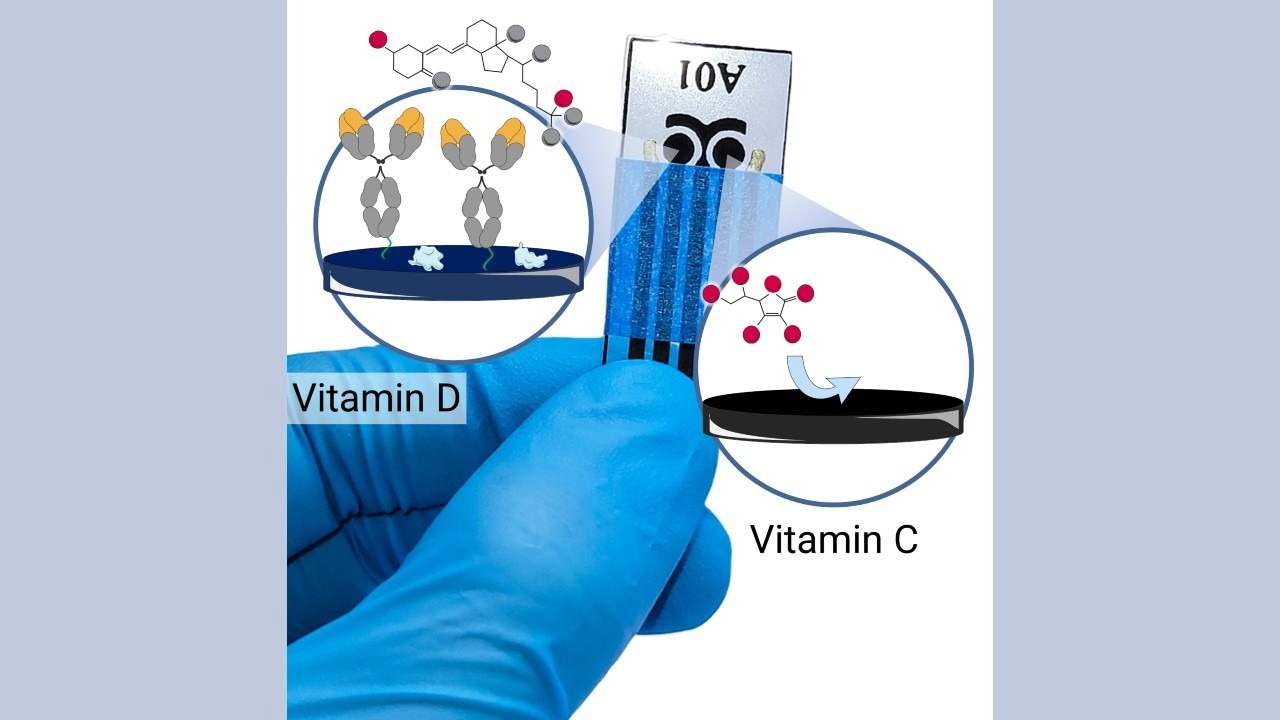According to a study published and featured on the journal cover of ACS Applied Nano Materials, scientists from the University of São Paulo (USP) in Brazil have created a bioelectronic chip that can concurrently detect vitamin D and C in bodily fluids. It is versatile and easy to use and can be customized for use in a wearable device to help with a customized diet.
 The chip contains two sensors, each using electric current to detect a vitamin. Image Credit: Martins, Thiago S. et al./ACS Applied Nano Materials
The chip contains two sensors, each using electric current to detect a vitamin. Image Credit: Martins, Thiago S. et al./ACS Applied Nano Materials
Vitamins C and D are micronutrients that play an essential role in the immune system by participating in metabolic pathways that battle viruses and bacteria. Monitoring these vitamins can ensure they are neither insufficient nor excessive.
However, the solutions now available for this necessitate the use of expensive laboratory equipment handled by highly trained personnel. They include collecting blood samples and generating hazardous waste. Detecting and analyzing both vitamins in the same sample is challenging.
Researchers from the São Carlos Institute of Physics (IFSC-USP) and FAPESP (projects 22/03758-0, 22/15122-3, 19/13514-9, 22/00243-0, and 18/22214-6) developed an electrochemical chip for self-monitoring vitamins C and D. The chip uses low-cost resources like carbon and rapid operating protocols to simplify the process.
The chip is disposable and has two sensors that use electric current to detect vitamins. In the case of vitamin C, the sensor is composed of carbon nanoparticles that function as an electrocatalyst. The vitamin D sensor comprises graphitic carbon nitride, gold nanoparticles, and a layer of 25(OH)D3 antibodies. 25(OH)D3 is the most abundant circulating form of vitamin D because of its long half-life.
The chip is simple to use. The user just connects it to a small portable electronic instrument similar to a glucometer, inserts a saliva or blood serum sample, and waits for the electric current to reveal the presence and quantities of vitamins. The outcome is obtained in less than 20 minutes.
By immobilizing electrochemically active species on the surface of one of the sensors, we were able to eliminate the need for labels and redox probes, simplifying the device and reducing the complexity of the analysis.
Thiago Serafim Martins, Study First Author and Researcher, Imperial College London
Martins added, “This makes the chip potentially more practical and efficient, enabling it to be used directly in pharmacies, clinics and so on. Also, it is flexible enough to be adapted for use as a wearable device, embedded in a mouthguard or teether, and applied directly to the skin.”
Its selectivity and specificity were validated in control experiments to assess potential interference from other substances often found in blood and saliva samples, such as vitamins B12, B1, and B3, glucose, lactate, sodium chloride, and potassium chloride.
Challenges
The biggest obstacle the researchers had to overcome to design a bioelectronic chip that could detect vitamins C and D was ensuring there would be no cross-reactions between the vitamins in the sample the chip analyzed.
Martins stated, “Making sure there would be no cross-reactions between the vitamins in the sample the bioelectronic chip analyzed was the biggest obstacle the researchers had to overcome to design a bioelectronic chip that could detect vitamins C and D.”
Although further study is needed to validate the sensors, the scientists believe that expanding the chip's detection capabilities to include additional biomarkers, such as those for various cancer types, is possible. Subsequently, they want to apply for a patent and, in due course, provide a manufacturing license for the invention.
Brazil’s National Council for Scientific and Technological Development (CNPq) further assisted the study.
Journal Reference:
Martins, T. S., et. al. (2024) Label- and Redox Probe-Free Bioelectronic Chip for Monitoring Vitamins C and the 25-Hydroxyvitamin D3 Metabolite. ACS Applied Nano Materials. doi:10.1021/acsanm.3c05701